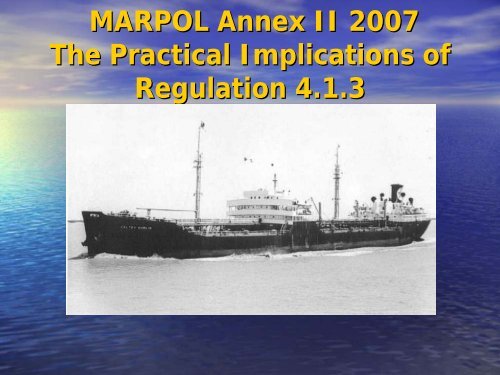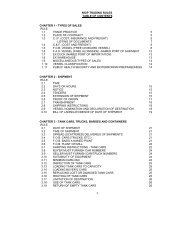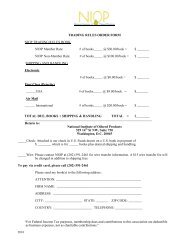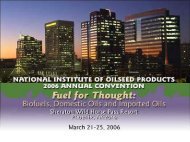MARPOL Annex II 2007 The Practical Implications of Regulation 4.1.3
MARPOL Annex II 2007 The Practical Implications of Regulation 4.1.3
MARPOL Annex II 2007 The Practical Implications of Regulation 4.1.3
You also want an ePaper? Increase the reach of your titles
YUMPU automatically turns print PDFs into web optimized ePapers that Google loves.
<strong>MARPOL</strong> <strong>Annex</strong> <strong>II</strong> <strong>2007</strong><br />
<strong>The</strong> <strong>Practical</strong> <strong>Implications</strong> <strong>of</strong><br />
<strong>Regulation</strong> <strong>4.1.3</strong>
What Prompted Veg Oils Being<br />
Reclassified ?<br />
• Uncontrolled discharges in the North<br />
Sea<br />
• Vegetable oils were classified as<br />
“persistent floaters” making them<br />
fall under the IBC Code<br />
• <strong>The</strong> removal <strong>of</strong> older product tankers<br />
from the trade
What Makes a Chemical Tanker<br />
a Chemical Tanker?
What Makes a Chemical<br />
Tanker a Chemical Tanker?<br />
• Certificate <strong>of</strong> Fitness<br />
• Procedures and Arrangements<br />
Manual<br />
• Underwater Discharge<br />
• Stripping Requirements<br />
• Crew Training
Certificate <strong>of</strong><br />
Fitness<br />
“Owners Instruction<br />
Manual for a Ship”
<strong>The</strong> Certificate <strong>of</strong> Fitness<br />
• Every chemical tanker is required to<br />
have a Certificate <strong>of</strong> Fitness (CoF) –<br />
indicating that it is certified to carry<br />
certain products.<br />
• <strong>The</strong> issuance <strong>of</strong> a CoF will also<br />
require a revised Procedures and<br />
Arrangements (P&A) Manual.
<strong>The</strong> Procedures and<br />
Arrangements Manual<br />
• <strong>The</strong> issuance <strong>of</strong> a CoF will also require a<br />
revised Procedures and Arrangements<br />
Manual<br />
• From January <strong>2007</strong>, chemical tankers will<br />
need new certifications and a new<br />
Procedures and Arrangements Manual<br />
• Certain veg oil cargoes because <strong>of</strong> their<br />
viscosity will be require pre-wash in<br />
accordance with the P&A Manual
<strong>The</strong> Procedures and<br />
Arrangements Manual<br />
• Vessels engaged in the oil and<br />
products trade are not required to<br />
have a P&A Manual<br />
• <strong>The</strong> requirement for a P&A Manual is<br />
laid out in <strong>MARPOL</strong> <strong>Annex</strong> <strong>II</strong> and the<br />
IBC Code
<strong>The</strong> P & A and Pre-wash<br />
• <strong>Regulation</strong> 8 <strong>of</strong> <strong>Annex</strong> <strong>II</strong> <strong>of</strong> <strong>MARPOL</strong><br />
73/78 require ships to conduct mandatory<br />
in-port pre-washes after unloading certain<br />
solidifying or high viscosity cargoes<br />
(including some veg oils)<br />
• After unloading a cargo tank containing<br />
certain cargoes the tank must be pre-<br />
washed in accordance with the procedures<br />
specified in the ship's P&A Manual.
Under Water Discharge
Under Water Discharge<br />
• An underwater discharge<br />
arrangement for tank washing water<br />
is required for pollution categories X<br />
and Y for ships keel-laid laid before 1<br />
January <strong>2007</strong>.<br />
• Newer ships will require such for all<br />
pollution categories X, Y and Z.
Stripping Requirements<br />
Cat<br />
BCH Ships<br />
Const. before 31/7/1986<br />
Existing IBC<br />
constructed from<br />
31/7/1986 but before<br />
1/1/<strong>2007</strong><br />
New Buildings<br />
Constructed from<br />
1/1/<strong>2007</strong><br />
X<br />
Pre Wash<br />
Strip to 300 Litres<br />
Pre Wash<br />
Strip to 100 Litres<br />
Pre Wash<br />
Strip to 75 Litres<br />
Y<br />
Pre Wash for high<br />
viscosity cargoes<br />
Strip to 300 Litres<br />
Pre Wash for high<br />
viscosity cargoes<br />
Strip to 100 Litres<br />
Pre Wash for high<br />
viscosity cargoes<br />
Strip to 75 Litres<br />
Z<br />
Strip to 900 Litres<br />
Strip to 300 Litres<br />
Strip to 75 Litres<br />
OS<br />
No requirements<br />
No requirements<br />
No requirements
Crew Training
Chemical Tanker<br />
Crew Training<br />
• For seafarers serving onboard<br />
Chemical Tankers, Certificate or<br />
documentary evidence issued in<br />
accordance with STCW Code<br />
• Dangerous Cargo Endorsement is<br />
issued by the flag state
Chemical Tanker<br />
Crew Training<br />
• This training includes chemical tanker<br />
safety, fire safety measures and systems,<br />
prevention and control <strong>of</strong> pollution,<br />
operational practice and obligations under<br />
applicable laws and regulations, the<br />
course covers all training necessary to<br />
apply the provisions <strong>of</strong> <strong>Annex</strong> <strong>II</strong> <strong>of</strong><br />
<strong>MARPOL</strong> 73/78.<br />
• This is not required for product tanker<br />
crews
<strong>The</strong> Veg Oil Compromise<br />
An Administration may exempt ships from the<br />
carriage requirements under <strong>Regulation</strong> 11 for<br />
ships Certified to carry individually identified<br />
vegetable oils identified by the relevant footnote<br />
(k) in chapter 17 <strong>of</strong> the IBC Code, provided the<br />
ship complies with the following conditions:<br />
1. Subject to this regulation, the NLS tanker shall<br />
meet all requirements for ship type 3 as identified<br />
in the IBC Code except for cargo tank location;<br />
2. Under this regulation, cargo tanks shall be<br />
located at the following distances inboard. <strong>The</strong><br />
entire cargo tank length shall be protected by<br />
ballast tanks or spaces other than tanks that<br />
carry oil
Differences in Tankers<br />
1) Oil Tankers<br />
-All slops go ashore<br />
2) Chemical Tankers<br />
-Oil slops go ashore.<br />
-Chemical pre-wash slops go ashore.<br />
-Overboard discharge according to Marpol<br />
<strong>Regulation</strong>s.
Cargo Tank Location <strong>of</strong> <strong>4.1.3</strong><br />
are Double Hull<br />
• Type 2 Chemical<br />
Tanker : 760<br />
millimeters.<br />
• Oil Tanker :<br />
1000 millimeters.
<strong>The</strong> Veg Oil Compromise<br />
• <strong>The</strong> intent <strong>of</strong> the language <strong>of</strong> the<br />
compromise was to allow double hull<br />
product tankers to be converted to<br />
Type 3 chemical tankers ( with a<br />
Certificate <strong>of</strong> Fitness, a P&A Manual,<br />
specialized training, etc)<br />
• Vessels are currently being converted<br />
from product tankers to chemical<br />
tankers
Conclusion/Questions<br />
• Is retro-fitting practical or possible?<br />
• <strong>Regulation</strong> <strong>4.1.3</strong> requires a chemical<br />
tanker<br />
• Product tankers can be used but<br />
certain design and operational<br />
changes need to be made






